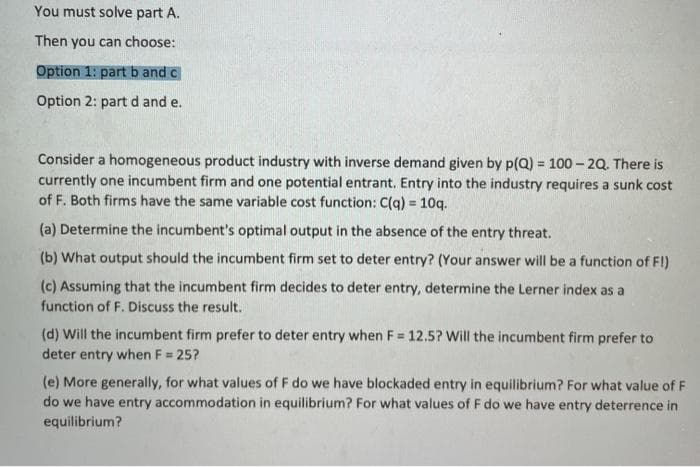Consider a homogeneous product industry with inverse demand given by p(Q) = 100 – 20. There is currently one incumbent firm and one potential entrant. Entry into the industry requires a sunk cost of F. Both firms have the same variable cost function: C(q) = 10q. (a) Determine the incumbent's optimal output in the absence of the entry threat. (b) What output should the incumbent firm set to deter entry? (Your answer will be a function of F!) (c) Assuming that the incumbent firm decides to deter entry, determine the Lerner index as a function of F. Discuss the result.
Consider a homogeneous product industry with inverse demand given by p(Q) = 100 – 20. There is currently one incumbent firm and one potential entrant. Entry into the industry requires a sunk cost of F. Both firms have the same variable cost function: C(q) = 10q. (a) Determine the incumbent's optimal output in the absence of the entry threat. (b) What output should the incumbent firm set to deter entry? (Your answer will be a function of F!) (c) Assuming that the incumbent firm decides to deter entry, determine the Lerner index as a function of F. Discuss the result.
Managerial Economics: A Problem Solving Approach
5th Edition
ISBN:9781337106665
Author:Luke M. Froeb, Brian T. McCann, Michael R. Ward, Mike Shor
Publisher:Luke M. Froeb, Brian T. McCann, Michael R. Ward, Mike Shor
Chapter18: Auctions
Section: Chapter Questions
Problem 18.6IP
Related questions
Question

Transcribed Image Text:You must solve part A.
Then you can choose:
Option 1: part b and c
Option 2: part d and e.
Consider a homogeneous product industry with inverse demand given by p(Q) = 100 – 20. There is
currently one incumbent firm and one potential entrant. Entry into the industry requires a sunk cost
of F. Both firms have the same variable cost function: C(q) = 10q.
%3D
(a) Determine the incumbent's optimal output in the absen
of the entry threat.
(b) What output should the incumbent firm set to deter entry? (Your answer will be a function of FI)
(c) Assuming that the incumbent firm decides to deter entry, determine the Lerner index as a
function of F. Discuss the result.
(d) Will the incumbent firm prefer to deter entry when F 12.5? Will the incumbent firm prefer to
deter entry when F = 25?
(e) More generally, for what values of F do we have blockaded entry in equilibrium? For what value of F
do we have entry accommodation in equilibrium? For what values of F do we have entry deterrence in
equilibrium?
Expert Solution
This question has been solved!
Explore an expertly crafted, step-by-step solution for a thorough understanding of key concepts.
This is a popular solution!
Trending now
This is a popular solution!
Step by step
Solved in 2 steps

Knowledge Booster
Learn more about
Need a deep-dive on the concept behind this application? Look no further. Learn more about this topic, economics and related others by exploring similar questions and additional content below.Recommended textbooks for you

Managerial Economics: A Problem Solving Approach
Economics
ISBN:
9781337106665
Author:
Luke M. Froeb, Brian T. McCann, Michael R. Ward, Mike Shor
Publisher:
Cengage Learning

Managerial Economics: Applications, Strategies an…
Economics
ISBN:
9781305506381
Author:
James R. McGuigan, R. Charles Moyer, Frederick H.deB. Harris
Publisher:
Cengage Learning

Managerial Economics: A Problem Solving Approach
Economics
ISBN:
9781337106665
Author:
Luke M. Froeb, Brian T. McCann, Michael R. Ward, Mike Shor
Publisher:
Cengage Learning

Managerial Economics: Applications, Strategies an…
Economics
ISBN:
9781305506381
Author:
James R. McGuigan, R. Charles Moyer, Frederick H.deB. Harris
Publisher:
Cengage Learning